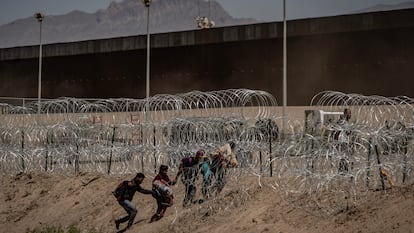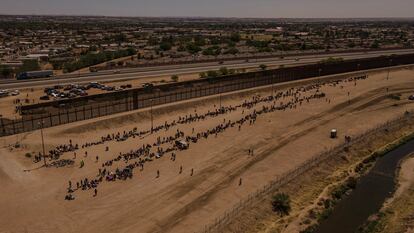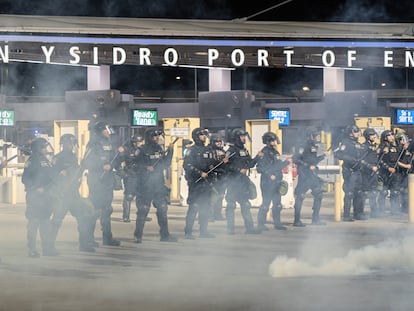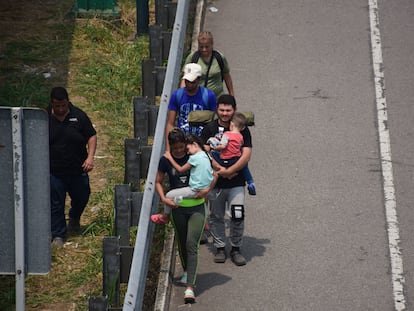Title 42: Thousands of migrants in limbo between the US-Mexico border
The end of Donald Trump’s Covid measure, which allowed the immediate expulsion of people, has not solved the problems in the area or between the governments of Joe Biden and Andrés Manuel López Obrador

At 9:59 p.m. MDT on Thursday, the United States and Mexico entered a new era of uncertainty in the history of their complex border relations. It is not always easy to pinpoint an exact moment of change, but on this occasion, it was: at that precise moment, 40 months and two judicial extensions later, Title 42, a temporary measure decreed by Donald Trump to halt the advance of the Covid-19 pandemic that allowed for the removal of would-be migrants to the U.S. without due process, ceased to be in force. In its place, Title 8 will remain in effect. The two have operated in tandem for just over three years. In practice, the change heralds a toughening of the conditions required to seek asylum, with unpredictable consequences. The only certainty is that migrants are continuing to arrive at the border in record numbers and that the problems arising between Washington and Mexico City from the crisis remain unresolved.

Title 42 profoundly changed the laws governing the Mexico-U.S. border and its end has thrown the dividing line between the two countries, a nearly 2,000-mile frontier reinforced over the past few days by 24,000 additional personnel, into one of the greatest crises in the memory of inhabitants on both sides, spurred by the chronic collapse of living conditions in Venezuela, Nicaragua, and Haiti. Citizens of these nations continued to arrive by foot on Thursday, having traversed as many as six countries, suffering unspeakable hardships and driven by desperation. On Wednesday alone, 10,400 people attempted to cross into the United States before it was too late. Authorities estimate that on the Mexican side of the border, 60,000 people are waiting for their chance. Some media outlets have put that figure at closer to 150,000.
When the clock struck 9:59 p.m., the invasion predicted by the most extremist factions within the Republican Party did not materialize. On the contrary, at Gate 42, located 11 miles to the east of El Paso, one of the hottest spots on the border, the eerie calm of the desert night reigned as around 400 migrants who had surrendered to U.S. Customs and Border Protection (CBP) patrols waited on the other side to be processed. Throughout the day, agents placed men and women traveling alone and families with small children into vehicles to transport them to centers where immigration officials would decide whether to apply Title 42 and remove them immediately, or whether they were eligible for Title 8 and a process to determine whether they qualified for asylum. Those that arrived after 10:00 p.m. all fell under Title 8.

Title 8 was used during the Barack Obama administration to deport more than three million migrants over eight years, but it now has some new features. For example, those who want to apply for asylum and can demonstrate that they have grounds to do so (because they are victims of political persecution or because their lives are in danger in their countries of origin) are required to apply before embarking on their journey through an application called CBP One. If they arrive in the U.S. without having met this requirement, they will be deported. The same fate awaits migrants apprehended while attempting to cross the border illegally. In contrast to Title 42 rules, which gave U.S. authorities the ability to carry out swift removals that carried no legal consequences, Title 8 allows those waiting to be deported to remain on U.S. soil in the meantime but also carries consequences including a ban on re-entry attempts for at least five years. Those caught trying to cross the border again in that timeframe face prison sentences in the United States.
Border Patrol Chief Raúl Ortiz, who had traveled to El Paso from Washington to personally oversee the transition, explained Thursday afternoon from the U.S. side that in the “last 48 hours, up to 2,500 people” had gathered on the other side of Gate 42, between the Rio Grande and the 20-foot-high fence that separates them from their dreams of a better life, a patch of dusty ground where the sun beats down mercilessly. On paper it is U.S. territory, although in practice it is no man’s land. “We are working to process and transport these migrants, prioritizing the most vulnerable groups, and in the safest and most efficient way we can,” Ortiz said. “We will continue this process over the next 24 hours.” Ortiz added that the number of people in custody along the entire border stood at 27,000 on Thursday.

In Ciudad Juarez, the sensation was one of urgency at the various border crossing points. Jessica, an NGO volunteer, told EL PAÍS that she had never seen the area so militarized. Dozens of Border Patrol and Texas State Police vehicles reconnoitered along miles and miles of barbed wire, the latter a detachment sent by Texas Governor Greg Abbott to contain a tsunami that — despite the Republican politician’s hyperbole throughout the crisis — did not come. At 9:59 p.m., the calm that is habitual at that time of night was maintained along the three bridges that link the Mexican city to El Paso. There were also no incidents in Yuma, on the Arizona-California border, where a group of 140 received the news that the U.S. Immigration and Customs Enforcement agency (ICE) plans to release them from detention centers on Friday to avoid overcrowding, on the condition that they report back within 60 days.
It is just one example of the extraordinary measures that federal, state, and local authorities have taken as Title 42 expires. It is hard to overstate how much is at stake for President Joe Biden on this issue, which will be key during the 2024 presidential elections. It is one of his weakest flanks against attacks by the Republicans, who have painted an apocalyptic picture of immigration under his administration and who on Thursday passed a tough draft bill on border policy in the House of Representatives, which however is unlikely to pass through the Democratic-majority Senate. The aim of the bill, conservatives say, is to fix a mess that they claim will allowing criminals and fentanyl to enter the country en masse.
The official line, repeated time and again by Homeland Security Secretary Alejandro Mayorkas, is that the end of Title 42 does not mean that the border is “open.” On Thursday, Mayorkas did venture, however, that “difficult days and weeks” lie ahead. Biden, for his part, went a little further by admitting that the situation could become “chaotic for a while.” Everything will depend on whether would-be migrants heed Mayorkas’ plea not to risk their lives to reach the United States, or whether they listen to the words of a paradoxical amalgam of Republicans and human traffickers, who would have them believe that the border will be more porous than ever as of Friday.

Deportations will be “immediate,” Mayorkas warned, and to countries of origin whenever possible. This will not apply to citizens of Venezuela, Cuba, Haiti or Nicaragua, countries with which the U.S. has no return agreements in place. The Biden administration and the government of Andrés Manuel López Obrador’s have reached an agreement for migrants from these countries to remain in Mexico. Between Wednesday and Thursday, U.S. authorities chartered two planes to carry deported migrants to Honduras and Guatemala from El Paso International Airport.
The last migrants to arrive in El Paso under Title 42 did so in the hope that they would be allowed to remain in the U.S., or that if they were expelled at least it would not be a deportation that would stay on their records. Over the past few days, hundreds of people who crossed the border illegally and slept on the streets agreed to turn themselves in. Some were deported, but many received papers allowing them to travel freely inside the country. Those who have not already embarked on onward journeys, heading for cities like Denver, where they have faith in the benevolence of the local authorities, or New York and Orlando, in search of family and friends, on Thursday morning wandered through the streets near the Sacred Heart Church, where up to 2,500 of them have been housed, asking for help to buy bus tickets. Those leaving ICE processing centers carried a piece of paper with an appointment to report to the immigration authorities — ranging from a few weeks’ time to four years away — for their cases to be ruled upon. The majority of them, an estimated 80%, never appear before a judge.
Sign up for our weekly newsletter to get more English-language news coverage from EL PAÍS USA Edition
Tu suscripción se está usando en otro dispositivo
¿Quieres añadir otro usuario a tu suscripción?
Si continúas leyendo en este dispositivo, no se podrá leer en el otro.
FlechaTu suscripción se está usando en otro dispositivo y solo puedes acceder a EL PAÍS desde un dispositivo a la vez.
Si quieres compartir tu cuenta, cambia tu suscripción a la modalidad Premium, así podrás añadir otro usuario. Cada uno accederá con su propia cuenta de email, lo que os permitirá personalizar vuestra experiencia en EL PAÍS.
¿Tienes una suscripción de empresa? Accede aquí para contratar más cuentas.
En el caso de no saber quién está usando tu cuenta, te recomendamos cambiar tu contraseña aquí.
Si decides continuar compartiendo tu cuenta, este mensaje se mostrará en tu dispositivo y en el de la otra persona que está usando tu cuenta de forma indefinida, afectando a tu experiencia de lectura. Puedes consultar aquí los términos y condiciones de la suscripción digital.
More information
Archived In
Últimas noticias
Welcome to the post-religion era: The idea of Christianity as the absolute truth has become obsolete
‘I thought you would like it’: The risky sexual practice popularized by TV shows and TikTok
The digitalization of tourism: ‘They promise experiences and gave us the worst possible one’
Mexican peso defies uncertainty with forecasts of a new period of stability in 2026
Most viewed
- Sinaloa Cartel war is taking its toll on Los Chapitos
- Oona Chaplin: ‘I told James Cameron that I was living in a treehouse and starting a permaculture project with a friend’
- Reinhard Genzel, Nobel laureate in physics: ‘One-minute videos will never give you the truth’
- Why the price of coffee has skyrocketed: from Brazilian plantations to specialty coffee houses
- Silver prices are going crazy: This is what’s fueling the rally










































